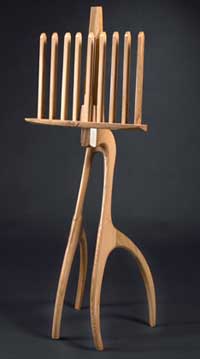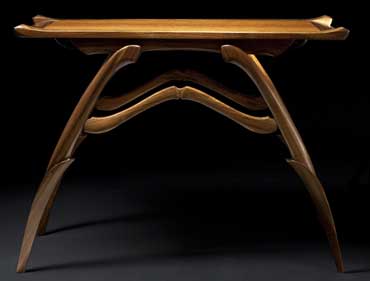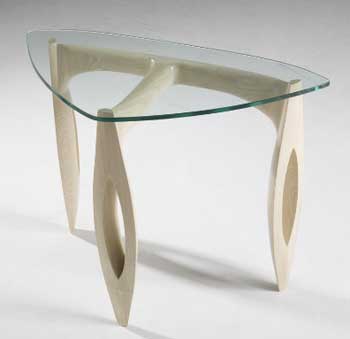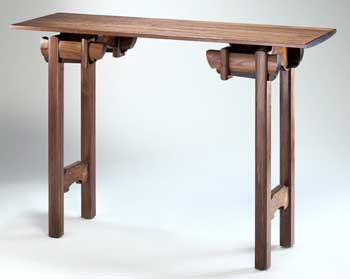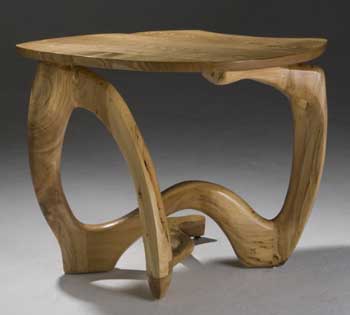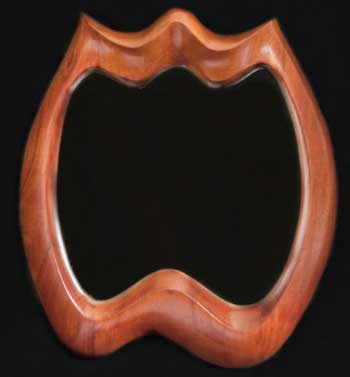
Glen Guarino has loved woodworking since he was a boy – and, as a retired high school shop teacher, passed along that love to other boys and girls. Now devoting himself full-time to making studio furniture, Glen is proud that he was able to pass along his New Jersey high school shop program to someone he got started in woodworking.
His own interest started when he spent a summer visiting an uncle in England. The uncle was between ships in the Merchant Marines, and he and Glen spent a lot of time making model sailing ships, and sailing some of them at a park. “Ever since, I’ve liked boats, and I’ve loved woodworking,” Glen said.
In fact, he liked it enough that, when it came time to seriously consider a career, he thought back to his choice of a ninth grade research assignment: what it would take to be a high school shop teacher. “It sounded like a neat idea. I’d get to be in the shop every day. Teaching appealed to me, and coaching.”
Glen spent 32 years as a high school shop teacher and wrestling coach. Along the way, he went to graduate school – in part to increase his teaching salary, and in part because he found a studio art program (at Kean University) he really liked. “I enjoyed having somebody else to bounce ideas off of and discuss the subject a lot more in-depth.”
It was at that time that Glen began taking commission work and, when he retired from teaching high school at the end of 2002, it was the furniture building that became his full-time job, with his wife Marie as his art agent.
Nowadays, when he meets people who ask him “what do you do,” and he responds that he is a studio furniture designer, many people, Glen said, are understandably confused, wondering what kind of furniture it is exactly that he makes.
“My kind of furniture, I kind of think of as functional sculpture,” Glen said. “I definitely think of it as an art form.”
“The favorite part for me, and maybe the hardest part, is the actual design,” he said. Rather than using a program like CAD, “I can sit down with a sketchpad and do a lot of sketches quickly,” he said. As he explores the design options, if he finds one that particularly appeals to him, he’ll build the design full-scale on paper or plywood, using tracing paper.
For a table, for example, he might have four or five different leg designs as options: “I’ll tape the tracing paper to the spot on the drawing where the leg will go.” Glen will then do several quick sketches of options for the design of the bottom of the leg and then, “if I find one I like, I’ll draw it hard on the full-size drawing.”
Sometimes, influences from other arts will show up in the work, although it’s not necessarily a conscious choice, Glen said. “I real fondness for art, and so does my wife. We go to museum shows and art shows, and I’m drawing from Eygptian art, Greek and Roman art. I try to expose myself to other fields: there’s something to learn from about every field that creates objects.”
In his own work, Glen said, “I’m looking for the ‘wow’ factor. The biggest compliment to me is if somebody looks at my work and says, ‘wow, that’s beautiful.’”
In addition to his focus on design, Glen says, “I really like and cherish that people can use that furniture tactically, whether it’s to write at a desk or eat at a table. I always try to build my furniture as strong as possible. I’ve had pieces that I sent out 20 years ago, and occasionally I have the opportunity to see them. They look just like I delivered them, and I’m pretty happy about that.”
Both his design and his construction are influenced by his shop, Glen said. Aside from assembling a few larger pieces at friends’ or the school shop, Glen builds most things in his small shop, with limited power equipment: a 20” Incra band saw, a cast-iron 12” jointer/planer combo, and an 8” Atlas table saw “that I bought from a friend for $25, 30 years ago, with the intention to get a new saw as soon as I built a bigger shop.”
Instead of building the bigger shop, Glen developed his hand tool skills, which has become his favorite way to do woodworking. “The wide belt sander and that type of work doesn’t appeal to me. What appeals to me is shaping wood, nice joinery, and the design of it.”
For instance, one of Glen’s favorite pieces is his Asian Interpretation hall table. “I like the simplicity of it. I enjoyed working on it: everything is hand shpaed with a plane or spokeshave.”
Glen’s quest for beauty also influences his choice in woods. One he considers the most beautiful – and “one of the few I will actually buy” – is Mozambique shedua. When he first ran across it, though, he wasn’t buying it:
“About 25 years ago, I had access to an old mill that started milling lumber around the time of the Civil War. There was a 12-13-foot deep dump outside this mill. When they’d start to mill a tree, the first board was curved, so the threw it out. The center board that holds the pith – they’d throw it it out.
“On weekends, I’d put on old clothes and take my Volkswagen Beetle to this dump. It wasn’t easy to get to: you’d have to fight bees’ nests, an occasional rat, and other stuff. Most of the domestic woods had rotted away and turned to dust. You’d pick up other stuff, and all of a sudden you’d hit on something heavy. I had my scrub plane with me, and I’d find out it was Mozambique” – or bubinga, purpleheart, rosewood, lignum vitae, or other exotic woods – “alongside the remnants of mahogany, right in the pile of dust and stuff.”
These days, Glen gets most of his wood from trees that have come down in his area. Some of his latest pieces were milled from a tree that came down across the street from his house: catalpa wood that he air dried. He’s also used elm, red oak and more. And, Glen says, “I seldom throw out wood., When I get done with a large project, I save the pieces. I’m usually able to get a mirror frame out of it, or something like that.
“Every piece I start, I try to do the elusive perfect piece, and I attack it with that intensity. I’m still working toward the best piece I’ve ever made, but I’m happy that I feel that my best pieces are the most recent.”
